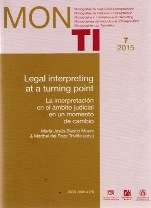Approaching the Bench: Teaching Magistrates and Judges how to Work Effectively with Interpreters
Main Article Content
Abstract
Downloads
Article Details
The documents contained in these directories are included by the contributing authors as a means to ensure timely dissemination of scholarly and technical work on a non-commercial basis. It is understood that all persons copying this information will adhere to the terms and constraints invoked by each author's copyright. These works may not be reposted without the explicit permission of the copyright holder.
References
Austin, John. (1962) How to do things with words. Oxford: Oxford University Press.
Berk-Seligson, Susan. (2008) “Judicial systems in contact. Access to justice and the right to interpreting/translating services among the Quichua of Ecuador.” Interpreting 10:1, pp. 9-33.
Berk-Seligson, Susan. (1990) The Bilingual Courtroom. Court interpreters in the judicial process. Chicago: The University of Chicago Press. Friedman-Rhodes, Elizabeth & Sandra Hale. (2010) “Teaching Medical Students to work with Interpreters.” The Journal of Specialised Translation 14, pp. 121-144.
Cook, Guy. (1989) Discourse. Oxford: Oxford University Press. Grice, Paul. (1975) “Logic and Conversation.” In: Cole, Peter & Jerry L. Morgan (eds.) 1975. Syntax and semantics. New York: Academic Press, vol. 3, pp. 41-58.
Hale, Sandra. (2014) “Interpreting culture. Dealing with cross-cultural issues in court interpreting.” Perspectives 22:3, pp. 321-331.
Hale, Sandra. (2013) “Helping interpreters to truly and faithfully interpret the evidence: The importance of briefing and preparation materials.” Australian Bar Review 37:3, pp. 307-320.
Hale, Sandra. (2011a) “The need to raise the bar: court interpreters as specialised experts.” The Judicial Review 10:2, pp. 237-258.
Hale, Sandra. (2011b) Interpreter policies, practices and protocols in Australian Courts and Tribunals. A national survey. Melbourne: Australian Institute of Judicial Administration.
Hale, Sandra. (2007) “The challenges of court interpreting: intricacies, responsibilities and ramifications.” Alternative Law Journal, 32:4, pp. 198-202.
Hale, Sandra. (2004) The discourse of court interpreting. Discourse practices of the law, the witness and the interpreter. Amsterdam & Philadelphia: John Benjamins.
Hale, Sandra. (2001) “The complexities of the bilingual courtroom.” Law Society Journal (July 2001), pp. 68-72.
Hale, Sandra & Ludimila Stern. (2011) “Interpreter quality and working conditions: comparing Australian and international courts of justice.” Judicial Officers’ Bulletin 23:9, pp. 75-81.
Hale, Sandra & Jemina Napier (forthcoming). “‘We’re just kind of there’: Working conditions and perceptions of appreciation and status in court interpreting” (Submitted, awaiting response).
Mikkelson, Holly. (2008) “Evolving views of the court interpreter’s role. Between Scylla and Charybdis.” In: Valero Garcés, Carmen & Anne Martin (eds.) 2008. Crossing borders in community interpreting. Definitions and dilemmas. Amsterdam & Philadelphia: John Benjamins, pp. 81-97.
Morris, Ruth. (2010) “Court Interpreting 2009: an undervalued and misunderstood profession? Or: will justice speak?” MonTI. Monografías de Traducción e Interpretación 2, pp. 47-79. Electronic version: http://rua.ua.es/dspace/bitstream/10045/16435/1/MonTI_2_04.pdf
Szldy & Ors vs Minister for Immigration & Anor [2008] FMCA 1684:16.
Wierzbicka, Anna. (2003/2009) Cross-Cultural Pragmatics. The Semantics of Human Interaction. Berlin & New York: De Gruyter Mouton.


